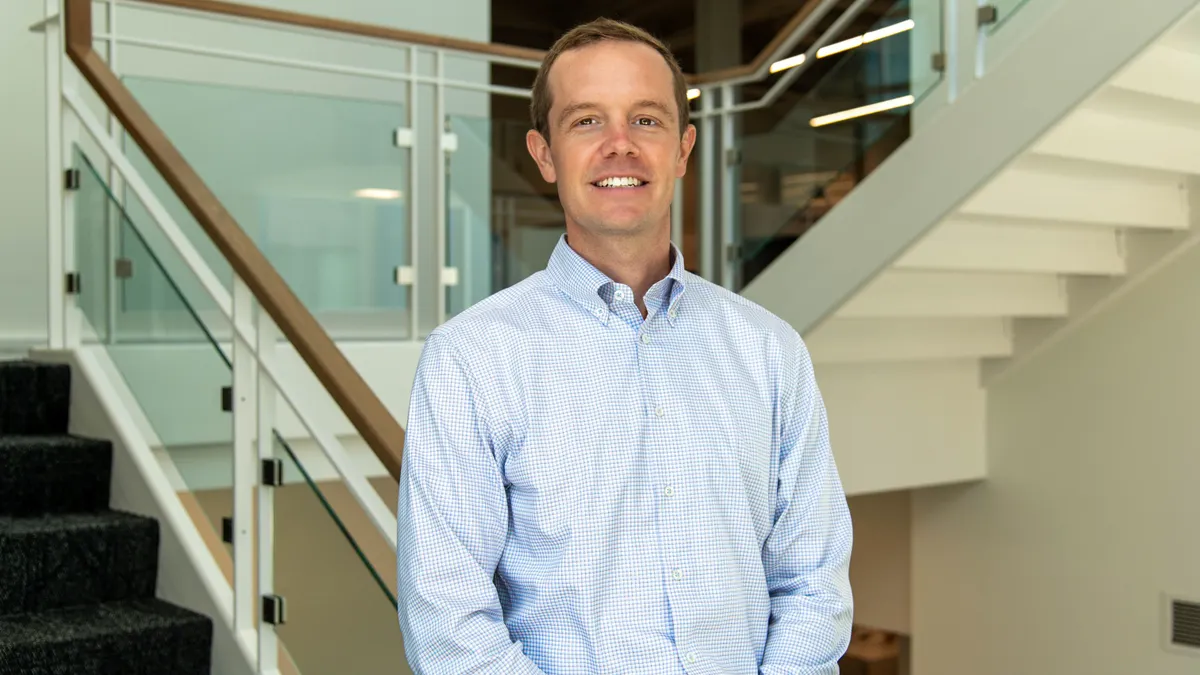Over the past year, Multifamily Dive has talked to more than 20 apartment executives to understand how the industry views centralization and how companies are adopting it. In coming weeks, we’ll post a series of stories from those interviews. To kick off the series, we're sharing five things operators need to know about moving their functions off-site.
Over the last five years, it’s possible no single word has been bandied about more among apartment executives and proptech providers than the term “centralization.”
At its core, centralization is about moving functions traditionally handled on-site, such as leasing, accounting, fraud detection and renewals, to an off-site location. Not surprisingly, those dramatic changes, which have upended the way apartments have been operated for decades, have come with controversy, with many executives wondering if customer service suffers when tasks are moved to remote locations.
However, some industry insiders like Tyler Christiansen think attitudes are changing. “Generally speaking, it's no longer viewed in a negative context,” said Christiansen, CEO of Funnel Leasing, a proptech firm based in Odessa, Florida.
Despite wider adoption, centralization is still complicated and challenging. Owners and operators need to wade in carefully to avoid common pitfalls. Here are some of the most important things to keep in mind as companies evaluate it as a potential solution:
1. It's not just for the big guys.
Woodmont Properties isn’t an apartment giant. The Fairfield, New Jersey-based owner and manager operates 3,000 units and has another 1,000 in the pipeline in northern and central New Jersey and the Lehigh Valley in Pennsylvania.
But that relatively small footprint isn’t stopping the company from aiming big. Woodmont is piloting its first centralized pod, where communities located near each other will share administrative resources.
“We are just going to run as if they were one and they are just physically separated by some miles,” Louis DeVos, vice president of property management at Woodmont.
“We've launched some different things relative to the bookkeeper position or the assistant manager position, where a lot of the accounts payable and accounting work gets centralized in some fashion."
Woody Stone
President of Cushman & Wakefield Multifamily Asset Services
DeVos said this is the first step in Woodmont’s quest to see how much of its on-site work can be centralized. “I know that we will be more efficient, and we’ll free up our associates' time to really interact with our customers and our prospects and give them as much undivided time as possible,” he said.
Woodmont isn’t alone. Tony Julianelle, CEO of Denver-based Atlas Real Estate, which manages 6,000 units, utilizes a call center in Mexico to triage and dispatch work.
“A work order comes in, and somebody has to vet that work order and triage it,” Julianelle said. “Having someone remote who’s bilingual doing it saves us a lot of money.”
Atlas also relies on its offshore customer service team to comb through resident data and ensure that it’s loaded correctly in its system. “They’re going through AppFolio and making sure that every box is checked the way it should be in the database,” Julianelle said.
2. It can be more difficult for third-party operators.
While large ownership groups like REITs can spread the costs of centralization across their portfolios, third-party managers face challenges.
“As a third-party manager, we manage for over 200 clients,” said Woody Stone, president of Cushman & Wakefield Multifamily Asset Services, the fifth-largest apartment operator in the country. “So, we don't control the real estate. We don't have some of the resources that a completely vertically integrated organization could apply.”
Third-party managers also report to many different owners, who are ultimately the bosses. Some groups may embrace centralization, while others prefer a more old-school approach.
“Not everybody sees it the same way,” Stone said. “So, trying to scale a solution is challenging as a third-party manager.”
Even a firm as big as Cushman & Wakefield is starting with small steps with centralization, according to Stone.
“We've launched some different things relative to the bookkeeper position or the assistant manager position, where a lot of the accounts payable and accounting work gets centralized in some fashion,” Stone said. “We do some centralized leasing, virtual tours and online leasing, as well.”
Ultimately, managers have to overcome objections from owners who are worried that they’re paying for maintenance on another group’s older property if it’s in the same pod.
“On the third-party side, you do have to have those conversations because asset managers are savvy and they want to make sure that they're being billed for the hours that someone's working on their property,” said Ian Bingham, senior vice president of business development at Buckingham Companies, an Indianapolis-based owner and operator with 13,000 units under management in secondary markets throughout the Midwest and Southeast.
3. It is driven by technology.
Whether for leasing, monitoring delinquencies and fraud or scheduling maintenance work, technology is crucial in centralization.
“One of the ways you can gain efficiencies at the site level is through technology,” said Mai Zhang, senior vice president of asset management for Boston-based apartment owner and developer The Davis Companies.
In a previous role at Maryland-based commercial real estate REIT JBG Smith Properties, Zhang spearheaded using artificial intelligence as the first interaction between residents and properties.
“Instead of having the leasing team field questions from prospects, it went out to a personal leasing agent [bot],” he said in a 2023 interview. “If you read the transcripts between the agent and prospects, it's gotten to the stage where it's so good that you can't tell the difference.”
However, leasing bots aren’t the only forms of AI that can handle on-site jobs. Atlanta-based apartment manager The RADCO Companies uses software platforms that monitor delinquency, handle revenue management and perform digital marketing, according to senior vice president of operations Chris Simon.
“If you read the transcripts between the agent and prospects, it's gotten to the stage where it's so good that you can't tell the difference.”
Mai Zhang
Senior vice president of asset management for The Davis Cos.
Indianapolis-based apartment owner and operator Gray Capital implemented Knock CRM to help with leasing follow-up and improve the experience. “It's taking the human out of the tasks that the humans aren't that great at, which is the follow-up and staying with prospects and automating that,” said Spencer Gray, the firm's CEO. “Then we bring in the human for the tour and interactions if someone wants to interact with a human.”
On the maintenance side, technology can also play a huge role in dispatching jobs to technicians and optimizing their service routes.
Buckingham uses technology to geo-locate its service technicians. “When your work order comes in, it's going to auto-direct the service ticket to the tech nearest to you with the best skill set,” Bingham said. “We’ve seen response time go down.”
4. It helps companies focus on strengths.
When Woodmont Properties decided to move its administrative functions off-site, it still needed someone to perform those tasks. Fortunately, the firm had a great candidate at one of its properties who was seeking a remote role.
“This is a remote position, which was attractive to somebody who we knew was very, very efficient and very good at mining the details,” DeVos said. “It also has a customer service component because this person will be responsible for asking people to pay the rent if they’re late.”
Moving the administrative position off-site also increases efficiency and decreases distractions, according to DeVos.
“You've got a UPS guy who wants your attention, you've got the dog walker, you've got a prospect coming in,” DeVos said. “They will get a lot more work done administratively within a day versus being on-site. That's the beauty of that position.”
In a centralized system, the people remaining on-site will be the ones who enjoy customer service. “We're trying to position our team members better to operate in strength,” Cushman & Wakefield’s Stone said.
The idea of letting on-site associates focus on their strengths extends to maintenance. Executives who have pooled their maintenance teams into pods serving multiple communities say that the system allows star performers to spend more time using the skills they specialize in.
“As the industry talks about this, the thing that I think everyone shies away from saying is they’re reducing headcount to save money.”
Ian Bingham
Senior vice president of business development at Buckingham Cos.
“It’s utilizing technology that automatically pushes out to our service technician — who has an HVAC certification — all of the work tickets that are HVAC related,” Bingham said. “Conversely, that service tech that’s fantastic at plumbing is getting all the plumbing tickets.”
5. It can lead to cost savings.
Allowing associates to play to their strengths is a benefit of centralization. But it's certainly not the only or even primary driver of adoption.
“A lot of operators lean on their property staff to wear a lot of different hats, and I think they're starting to see there's actually significant cost savings in starting to centralize operations,” said Aaron Ru, a principal at Park City, Utah-based real estate technology venture capital firm RET Ventures.
Still, in conversations with operators about what’s driving centralization, Multifamily Dive noted that only a few mentioned cost savings as a benefit. “As the industry talks about this, the thing that I think everyone shies away from saying is they’re reducing headcount to save money,” Bingham said. “But, I believe that eventually, there’s a degree of truth to that.”
When RADCO set up a centralized processing unit, it alleviated the need for some of its on-site positions. “We decreased the payroll from a property perspective and rolled that up to a corporate standpoint,” Simon said.
Automating management tasks has a clear benefit in an environment where labor costs are rising. “The cost of human capital — the cost of team members — has gone up significantly,” Stone said.
Those cost savings might not come from direct layoffs, however. In some cases, companies simply aren’t backfilling after associates leave and using technology to fill in the gaps. “We did take some jobs that were open and just didn't touch them,” Bingham said. “There's payroll savings there.”
Turnover is another issue. As employees leave, apartment operators need to find replacements. If some of those tasks can be automated, the operation can keep running in the face of attrition.
“If you can centralize some of these functions, creating more predictable output, you, in effect, hedge against some of those increasing costs and some of the turnover,” Stone said.
Click here to sign up to receive multifamily and apartment news like this article in your inbox every weekday.



















